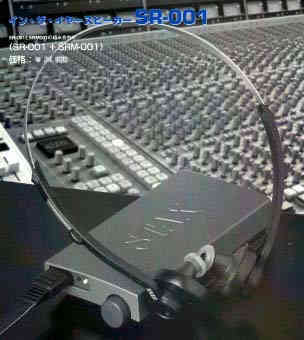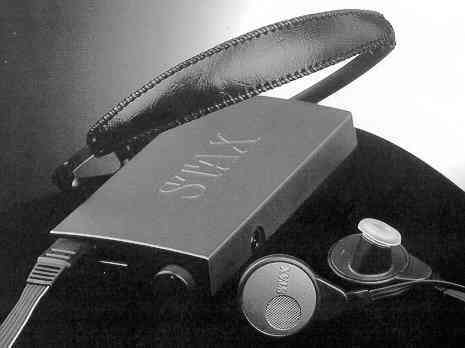Site Map Use the dropdown bar to navigate.
|
Site Map Use the dropdown bar to navigate. |
STAX SR-001 Portable Electrostatic Ear-speakers

These Stax SR001 Portable Electrostatic Ear-speakers are the latest addition to my arsenal of 'Cans'.
When my ear-buds for the Sony Minidisc Walkman broke, I was put in the position of having to purchase a good pair of headphones for portable use. As luck would have it, my local dealer had a pair on demo. I had quite lengthy demo and was very impressed at the results that I had received. Unfortunately for me, I didn't have the resources to purchase them at the time and had to wait a few weeks before I could get them.
The STAX SR-001's are the newest addition to the STAX product line, and are the culmination of 35 years continuous research and development of electrostatics ear-speaker design. STAX describes them as ear-speakers as they give a performance that is unlike any other headphone, indeed they do sound more akin to speakers than any types available.
The SR-001 package itself, consists of the Ear-speakers part (S-001) and Driver Unitpart(SRM-001). The "In The Ear-speakers" describes exactly and frankly the basic function of the The SR-001. "In The Ear-speakers" are lightweight and will fit into your ears while supplying you with unbelievable sound. They are without doubt, the lightest ear-speakers ever created by STAX, the actual "in the ear" units weighing only 12 grams (0.39 ounces)/a pair. The ultra - lightweight SRM-001 driver unit weighs only 140grams (4.5ounces) with its two AA batteries (supplied) intact.

The SRM-001 driver unit will fit comfortably and unobtrusively in your shirt pocket. You can connect it to portable CD or DAT player, or of course the increasingly popular Mini-Disc player. Of course, the more traditional Walkman or pocket radio is also possible.
The exclusive SRM-001 driver units with two AA batteries will drive your SR-001 "In The Ear-speakers" from between 2 to 5 hours depending on battery condition and use. A commonly available AC adapter supplying 4.5V at 300-400mA may also be used, but battery operation is more desirable in terms of sonic performance.
For those who have been wanting a lightweight, but sonically excellent headphones, the SR-001 "In The Ear-speakers" are the answer! For those finding less than adequate performance in inner-ear miniature headphones, the SR-001 package is the answer.
SPECIFICATIONS of SR-001
S-001 (Ear-speaker part)
Type |
ELECTROSTATIC CANAL TYPE IN THE EAR-SPEAKERS / PUSH-PULL DRIVEN |
Frequency Response |
20 - 1kz+-2DB, 1kz - 20kz+-4db |
Capacitance |
44pf with cable, 17pf without cable |
Impedance |
360k Ohm / 10kHz |
Sensitivity |
111db / 100V r.m.s/1kz |
Maximum Sound Pressure Level |
119DB / 1kz |
Standard Bias Voltage |
580V DC |
Recommended Operating Temperature |
0C - 40C (32F - 104F) 20% - 70% RELATIVE HUMIDITY |
Left / Right Indication |
INNER SIDE of the EAR-PEACE + 3-dots for LEFT, RED BAND on the CABLE for RIGHT |
Ear Fitting Rubber |
MADE of SILICON RUBBER / 3-sizes (LARGE / MEDIUM / SMALL) |
Cable |
6 - CORE PARALLEL / 1.5m (4 feet 11 inches) |
Weight & Size |
28g with CABLE, 12g without CABLE, 28mm DIAMETER 0.9 ounce with CABLE, 0.39 ounce without CABLE, 1-1/10 inch DIAMETER |
SRM-001 (Driver Unit Part)
Frequency Response |
5 - 20kz /+-0,-3db (10V r.m.s OUTPUT driving S-001) |
Gain |
54db (500 TIMES by VOLTAGE) |
Harmonic Distortion |
0.1% (1kHz / 100V r.m.s OUTPUT driving S-001) |
Input Impedance |
10k Ohm |
Standard Input Level |
100mV for 50V OUTPUT |
Maximum Output Level |
240V r.m.s / 1kHz |
Power Consumption |
1.3V / 4.5V (AC/DC ADAPTOR OPERATION) 0.8V / 3V (BATTERY OPERATION) |
Minimum Voltage needed for Operation |
2.05V (INDICATED RED LED instead of GREEN LED) |
Recommended Operating Environment |
0 C - 40 C (32 F- 104 F) 20% - 70% RELATIVE HUMIDITY |
Dimensions |
60 mm (W) x 24 mm x 120 mm (D) 2.3 inch (W) x 0.94 inch (H) x 4.7 inch (D) |
Weight |
102g without BATTERY 140g with STANDARD DRY CELL BATTERIES 3.28 ounces without BATTERY 140g with STANDARD DRYCELL BATTERIES |
Required Battery |
2 x AA Cells |
Mick Evans 1999
Last updated 11 July 2000
e-mail [email protected]